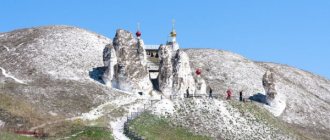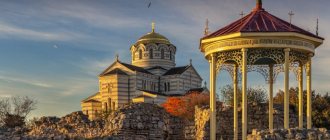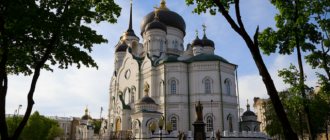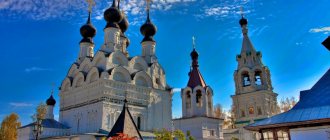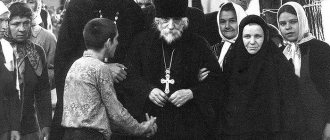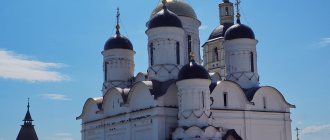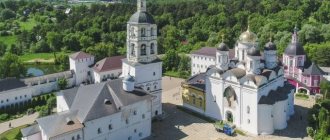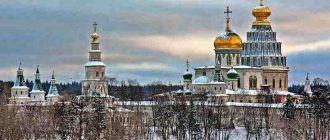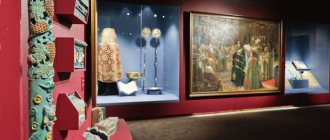Connoisseurs of unique landscapes, lovers of history, archeology and ancient architecture will be interested in visiting the Divnogorye farmstead, located near Voronezh. The settlement itself and the natural architectural and archaeological museum-reserve owe their beautiful name to the chalk pillars, which the inhabitants of these places called “divas”. The main attractions of the complex, which occupies 11 square meters. km, - an ancient settlement and temples carved into the chalk deposits.
Map of the Divnogorye Museum-Reserve
Let's start our story with a map of the reserve's facilities - this will immediately give you the opportunity to see a list of attractions and their locations (click to enlarge the map).
Map of the Divnogorye Nature Reserve
- Administration and cash desk
- Divnogorskoye Compound
- Divas
- Start of excursions
- Cave Church of the Sicilian Icon of the Blessed Virgin Mary
- Mayatskoye settlement
- Geological and paleontological exhibition “Childhood of the Earth”
- Divnogorsky Canyon
- Archaeological Park
- Paleolithic site and remains of ancient horses
- Source
- Recreational area
- Quiet Pine River
- River Don
- Paleolithic workshops
Sicilian Divnogorsk Icon of the Mother of God
The main shrine of the monastery. It was brought from Sicily by the Greek monks Xenophon and Joasaph, the legendary founders of the monastery. During the cholera epidemic in the 19th century, the Sicilian icon became famous for its many healings, so people began to call it “Healing”. In the icon, the Mother of God is depicted sitting on a throne. In her right hand is a white lily, with her left hand She supports the Infant Christ, who sits on Her lap. In the Savior's left hand is a lily, with His right hand He blesses. Eight angels are depicted around the Virgin Mary. Above Her head is the Holy Spirit in the form of a dove. The celebration of the icon is February 18. A list of the icon is available for veneration; it is located in the Assumption Church of the monastery.
Sights of Divnogorye
Big and Small Divas
On the steppe plateau, chalk remains rise in the form of bizarrely shaped pillars. Now there are only six of them left, although previously there were more than twenty. The pillars (divas) were destroyed during the Great Patriotic War and later during the construction of the railway.
The Big Divas are located near the administration of the museum complex, and the Small Divas are on the lands belonging to the monastery, north of the reserve.
Small Divas - cave temple (photo: Sergey Sergeev)
There is another pillar - the Lonely Diva, located on the eastern side, there is no road or path to it.
Church of the Sicilian Icon of the Blessed Mother of God
According to the monastery legend, the image of the Sicilian Mother of God was brought to the Divnogorsk plateau by two Orthodox monks who fled from Italy to Rus' from persecution by Catholics. According to legend, the icon ascended to the pillar on its own, marking the place that it would protect. Unfortunately, the original of the Sicilian icon has been lost, but in Divnogorye there is a copy made from it in the 19th century.
Church of the Sicilian Icon of the Mother of God
Please note: it is cold inside the caves even on the hottest summer day (about 10-12C), so bring warm clothes.
Mayatskoye settlement
The most ancient buildings discovered by archaeologists within the boundaries of the current Divnogorye Museum-Reserve in the Voronezh region are fortress walls, potters' workshops and the burial ground of the Mayatsky settlement. A rectangular fortress made of chalk with six-meter ramparts was built on a high cape at the place where the Don and Tikhaya Sosna rivers merge in the 9th-10th centuries. The white stone walls were an excellent landmark or beacon for the entire area, which is probably where the name of the settlement came from.
Research here began at the end of the 19th century, scientists found that a Khazar aristocrat lived in the Mayatsky fortress with his warriors and personal guards. In the Divnogorye Museum you can see found kitchen utensils, weapons, beads, and runic inscriptions that have not yet been deciphered have been found on the rocks. The cape on which the settlement is located is an excellent viewing platform. It offers wonderful views of the surrounding area.
Divnogorsky Canyon
A short distance from the Mayatsogo settlement there is a large canyon with chalk slopes. Streams of water carved its slopes with deep wrinkles. The canyon looks very picturesque.
Archaeological Park
Not far from the settlement there is an archaeological park, which is a reconstruction of a medieval village with adobe huts and various household items.
Divnogorye (photo: kladez-zolota.livejournal.com)
Archaeological Park “From Nomads to Cities”
Other caves of the reserve
There are a great many different caves dug in thick layers of chalk rocks on the Divnogorye plateau. In order to escape from raids and destruction in troubled times, the monks built underground tunnels of complex configuration, located at different levels, connected by passages and stairs. Many inhabitants of the monastery are buried in such dungeons.
The reserve also includes the following caves: Selyavninsky cave complex, Ulyana cave, Mount Shatrishche. There is an unfinished cave church on Mount Shatrishche. To view it, you need mountaineering training and special equipment.
Cretaceous outcrop near Mount Shadrische (photo: divnogor.ru)
Holy Dormition Monastery
To protect Russian lands from constant attacks by nomadic Tatars, the Holy Dormition Monastery was founded in 1653 on the Divnogorye plateau. All its premises were located inside a chalk mountain, the main structure being the cave temple of John the Baptist.
Temple of John the Baptist
The monastery existed safely until the 20s of the last century, but then it was destroyed and closed, and in its place a rest home was opened, then a hospital, then a sanatorium. In the 90s, the monastery was returned to the diocese, and services and restoration work began there, which are still ongoing.
Divnogorye - monastery (photo: palomnik-dmitry.ru)
Here you can see caves that served as cells for hermit monks. Now the monastery in Divnogorye is active; its inhabitants maintain the cave churches in proper condition and perform divine services in them.
Please note: the Holy Dormition Divnogorsk Monastery is not included in the reserve. Excursions and visits there are organized separately. You can leave an application on the official website of the monastery, Divnogorsky-monastery.rf, or by calling +7 920 436 3257.
Small Divas
In the cave part of the Church of the Nativity of John the Baptist in Malye Diva Photo by Vladimir Eshtokin
The name Divnogorye comes from the word Diva - chalk pillars, rocks left after the destruction of the soft rock that surrounded them. A little less than 10 divas with a height of 7 to 20 meters have survived. They make up two complexes - Big and Small Divas. In Bolshie Diva, where the museum-reserve is, there are more remains. And the monastery is in Malyye.
Nature
According to geologists, the surface of the Divnogorsk steppe plateau consists of hard layers of chalk (in some places up to 100 m thick) and a thin layer of soil. This relief originated during the Miocene period (more than 5 million years ago), when there was an ancient sea on the territory of the Voronezh region. Later, its waters dried up, and the bottom, on which the remains of plankton and other living organisms accumulated for thousands of years, became a hilly plain. Now the Don and Tikhaya Sosna rivers flow here.
A special microclimate has formed on the steppe plateau. The weather in Divnogorye is usually hotter and drier than in other areas of the region, due to the fact that the elevated surface of the plateau quickly heats up, and warm air, rising, disperses the clouds.
The nature of Divnogorye is very diverse. Flowers and herbs of alpine meadows and several types of steppes grow here, there are representatives of the Mediterranean fauna and relict plants. The plateau is home to many species of insects, over 20 of which are listed in the Red Book.
Feather grass steppe (photo: divnogor.ru)
Chalk monasteries
Man-made cave complexes occupy a special place among the attractions of Divnogorye.
There are 6 cave complexes in Divnogorye. They are located on an area of about 8.5 kilometers and are carved into the chalk slopes. The smallest cave is about 27 meters long, and the largest is up to 351 meters.
By the way, please note that people have been using caves since the Stone Age. But today these are mainly various religious temples, for example, the Dambulla Temple on the island of Sri Lanka or the Maijishan Caves in China.
How to get there
Official address of the museum-reserve:
- Voronezh region, Liskinsky district, Divnogorie village, lane. Divny, 27.
You can get here by bus, electric train or car. The distance from Voronezh to Divnogorye in a straight line is 79 km, along the highway – 123 km.
- By car. A car trip from Voronezh will take 1 hour 45 minutes heading south, approximately half of the route passes along the M-4 toll highway.
- By train. From May 4, 2022, on Saturdays you can travel from Voronezh to Divnogorye by direct train. It departs at 9-19 am and returns to Voronezh 1 central station at 18-20. In 2 hours and 15 minutes, the electric train reaches the Divnogorskaya station, where the Holy Dormition Monastery is located, then you need to drive another 5 minutes to the 143 km stop, where the museum-reserve is located. The Voronezh-Liski and Liski-Divnogorie electric trains run all year round; with a transfer you can get there in 2.5 hours. Trains depart from Voronezh every three hours, from Liski three times a day: in the morning, at lunch and in the evening.
- By bus. The Liski-Kovalevo regular bus runs through the Divnogorye village, departing from the square adjacent to the railway station from 6-00 to 18-00 with an interval of 2-3 hours.
Pilgrim[edit]
Schedule of services:
6:00 - Brotherly prayer service, Midnight Office.
7:15 — Divine Liturgy.
16:00 — Evening service.
Excursions
The excursion service of the monastery introduces guests and pilgrims to the spiritual and historical heritage of the monastery, its temples, including the cave temple, unique natural landscapes, chalk mountains with miraculous Divas. You will be able to pray at the main shrine of the monastery - the miraculous icon of the Mother of God of Sicily or Divnogorsk, and learn about the life of the monks of the monastery. The tours are conducted by experienced guides and residents of the monastery.
You have the opportunity to use the electronic APPLICATION FOR VISITING THE MONASTERY
, order a planned pilgrimage to the holy monastery, indicating information about yourself, desired excursions, meals, and overnight accommodation.
Where to stay
There are three ways to accommodate guests in Divnogorye:
- Hotels and guest houses. The recently opened hotel of the Divnogorye Museum-Reserve with 28 beds is located on the farm at the address: st. Podgornaya, 48. Reservations should be made in advance, especially in the summer. The hotel is within a few minutes' walk of the main attractions. Cost of living is 600-700 rubles. per person per night. Phone: +7 960 133-91-79, coordinates: 50.958774, 39.301365.
- Private guest houses. Residents of the Divnogorye village rent houses or rooms to visitors for a price starting from 500 rubles. per person per night. If you are not satisfied with your holiday in Divnogorye, you can stay in guest houses or hotels in Liski and Ostrogozhsk. >> Guest house "Trava-Murava" - a clean and cozy house in a rustic style 500m from the hotel "Divnogorye" View prices
>> "House on a Farm" - a guest house on the street. Podgornaya near the reserve. You can find out prices and make reservations by phone. +7 920 426-06-77
>> Mini-hotel "Granat" in the town of Liski (40 km from Divnogorye) - each room has air conditioning, WI-Fi, its own kitchen and bath. View prices
>> There are also other hotels in Liski, you can choose the right one here: - Tents. Next to the museum administration there is a camping area where you can pitch a tent. There is water, electricity, toilet, outdoor shower and a large table with a canopy. There is a fee of 100 rubles for placement. per day per person. You need to reserve a place on the site before your trip. If the weather permits, travelers stay in tents in the floodplain of the Tikhaya Sosna River, where a tourist and recreational zone has been designated. There is no infrastructure, but you can swim, sunbathe, fish and listen to birdsong. There is no need to pay money for accommodation.
On the territory of the museum-reserve there is free guarded parking and a summer cafe. In the immediate vicinity of the complex, on the farm, there are two grocery stores, but it is better to bring drinking water and food with you or buy it in Liski. There are no ATMs here, you need to stock up on cash.
What souvenirs can you buy?
Tourists who come on an excursion to the museum-reserve will certainly want to bring memorable souvenirs that remind them of their visit to this unique place.
In the souvenir shop of the nature reserve, you can buy bells with images of the temples and monastery of the Great and Small Divas, made of ceramics.
The pottery workshop produces mugs with the marks of the masters, in the likeness of ancient utensils that were used by the inhabitants who lived in these places long before us.
Samples of these products are also presented in the souvenir shop and are readily purchased by tourists.
Excursions
The opening hours of the Divnogorye Museum-Reserve in 2022 are from April 27 to November 5. During this period you can book an excursion from Voronezh:
You can also book excursions on site. Visitors are offered the main tour - a two-hour excursion around the Mayatskoe settlement and caves located in Bolshaya Diva.
An extended tour of 3 hours can be purchased. In additional time, the guide will take guests around the plateau and tell them about the geological features, flora and fauna. Two-hour group excursions called “Journey to the Kingdom of Chalk” are held for children of primary and secondary school age.
Divnogorye - excursion
From May to September the exhibition “Childhood of the Earth” is open. Here you can see original archaeological finds and 3D models, and get acquainted with the process of formation of the modern natural landscape of Divnogorye. Excursions are conducted on weekends and holidays upon prior request at 14-30 for groups of 10 to 30 people.
From May to August, a three-hour tour “Steppe Flora of Divnogorye” is available, and from May to mid-July you can get acquainted with insects, lizards, snakes, birds and marmots during the three-hour tour “Old-Timers of Divnogorye. In the animal world".
Another thematic excursion is dedicated to archeology, it is called “Necklace of Antiquity” and includes a visit to the archaeological park “From Nomads to Cities”.
The total cost of three-hour excursions is 380 rubles. for one person, two-hour – 260 rubles. Schoolchildren, pensioners and students must pay 195 rubles, 200 rubles, 205 rubles for 3 hours, respectively, and 135 rubles, 140 rubles, 145 rubles for 2 hours. The museum-reserve provides benefits to participants of the Great Patriotic War, pupils of orphanages and boarding schools, large families, disabled people, conscripts, Suvorov and Nakhimov students.
The schedule of excursions for individual travelers is posted on the official website of the Divnogorye Museum-Reserve. Organized groups must book the tour in advance.
You can walk around the territory of the museum-reserve for free on your own without a guide. But visiting the archaeological park and caves in Big Diva in this case will not be available.
At the end of the tourist season (after November 5), you can book a tour in advance for a group of 7 or more people.
Current state[edit]
In 1997, the land and buildings of the monastery were officially transferred to the Russian Orthodox Church. Soon divine services began, and then large restoration work began; the monastery's economy was equipped under the leadership of Archimandrite Parthenius (Shalatonov). In 2009-2015 The abbot of the monastery was Abbot Maxim (Lapygin), who gathered a small brethren and established a daily cycle of worship.
Currently, the abbot of the monastery is Hieromonk Alexy (Sukachev), who continues to develop and support good traditions and monastic rules. Currently, divine services are held daily, restoration work is underway, subsidiary farming is being developed, namely: cattle breeding, poultry farming, agriculture (vegetable garden, vineyards), apiary, there is a mini-bakery, prosphora bakery. A pilgrimage service operates to help pilgrims.
On the way of the Tatar invasion
The choice of the location of the monastery, given the situation at the end of the 17th century, could not be called successful. The monastery was often attacked by Tatars. Under Abbot Tikhon, part of the brethren left the monastery. They went to quieter places - west of the Don River. There, above the Psel River, the fugitives founded a monastery, which uninvited guests from the Golden Horde could no longer reach.
In the summer of 1770, the monks of the Divnogorsk monastery witnessed battles between the Cossacks under the leadership of Stepan Razin and the tsarist troops. The main events of the Peasant War unfolded here. The rebels suffered a severe blow. They left the bank of the Don. But the departure of the rebels did not bring peace to the novices of the Divnogorsk monastery.
The monks who remained in the monastery despite the danger from the Tatars had to learn the basics of self-defense. They installed iron and copper pipes on the bell tower. In case of danger, they hastily took refuge in a cave, which had several exits. In 1677, the Tatars attacked the monastery again, after which the monks spent a long time restoring their buildings.
Becoming
By the end of the 17th century, the monastery became a center of education and the fight against schism. There was a good library here for those times. In 1686, the abbot became an archimandrite. One of the monks went to Cherkassk, where he preached for two years. True, the local residents did not greet him cordially, and the monk had to return to his native monastery without eating.
Several decades after the founding of the monastery, these places were no longer so deserted. Residents of Little Russia flocked here, settled and influenced the local culture. The settlers took part in the expansion of the monastery.
A certain general, sailing from Voronezh to Azov in 1696, saw the monastery from afar and left enthusiastic notes about it in his diary. He was struck by a small structure, equipped with cannons, arquebuses and had fortifications that, it would seem, no enemy could overcome.
Mayatskaya Fortress and Archaeological Park
At the top of the chalk hill, the remains of an ancient settlement have been preserved. This is the Mayatskaya fortress or the Mayatskoye settlement. The first mention of it appeared in 1648. Then there was a fortress and other buildings. Now only barely noticeable ruins remain, but if you go a little further, you will find yourself in the Archaeological Park, in which the life and houses of that time have been recreated.
Archaeological park in Divnogorye
Reconstruction of an ancient home
Reconstruction of ancient life
